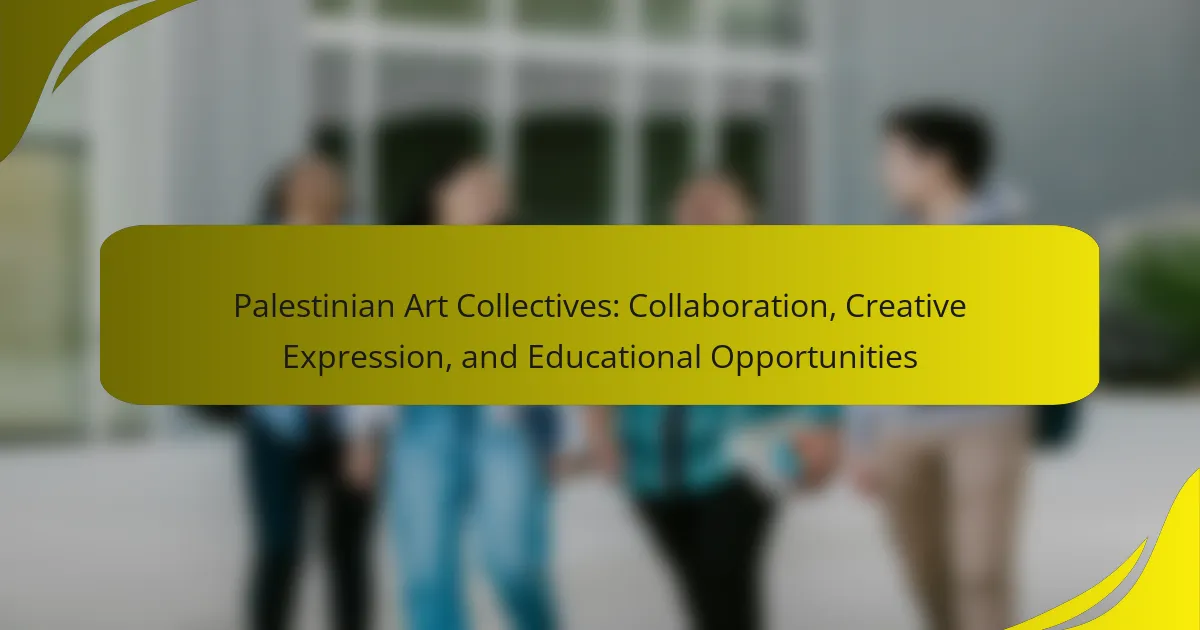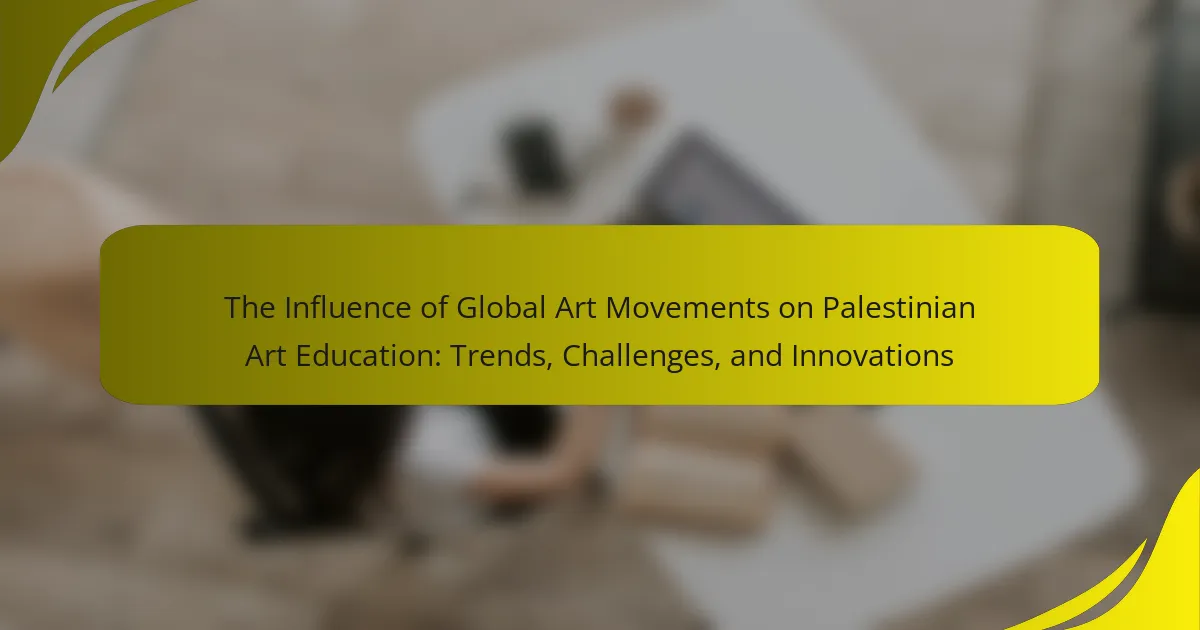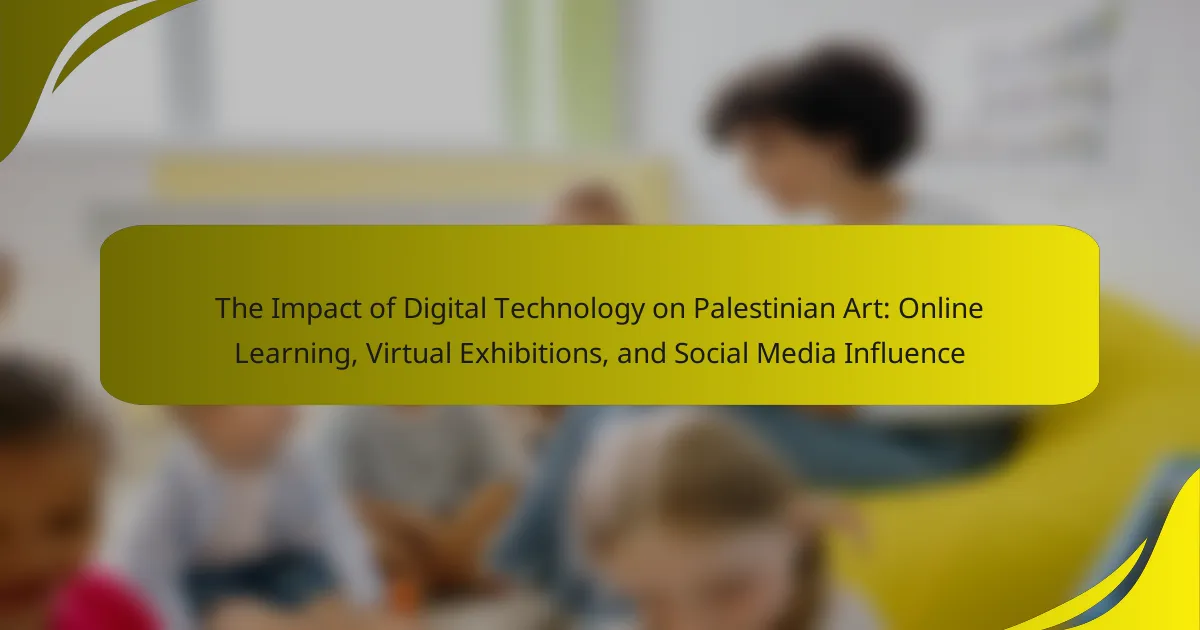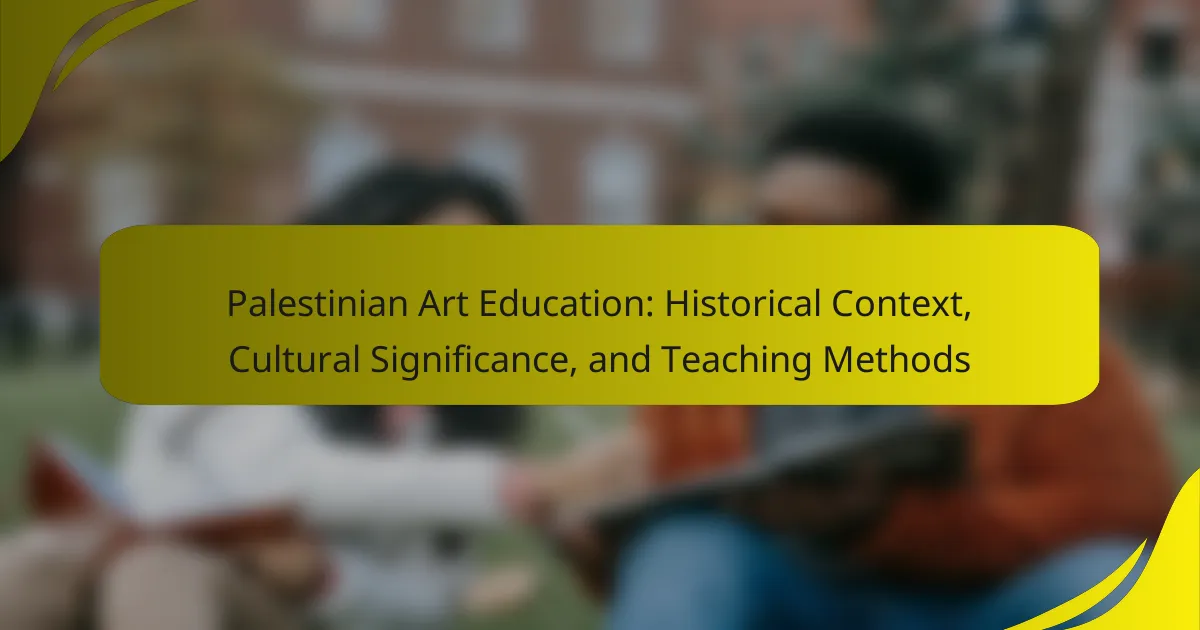The article examines the relationship between politics and Palestinian art education, highlighting how sociopolitical contexts shape artistic expression and educational practices. Palestinian art education functions as a platform for political activism, reflecting the struggles and aspirations of the Palestinian people. It incorporates themes of identity, resistance, and cultural heritage into the curriculum, fostering political awareness among students. Historical events, particularly the Nakba, are integrated into the educational framework to help students understand their cultural narratives within a political context. This approach positions art as a vital tool for advocacy and social change.
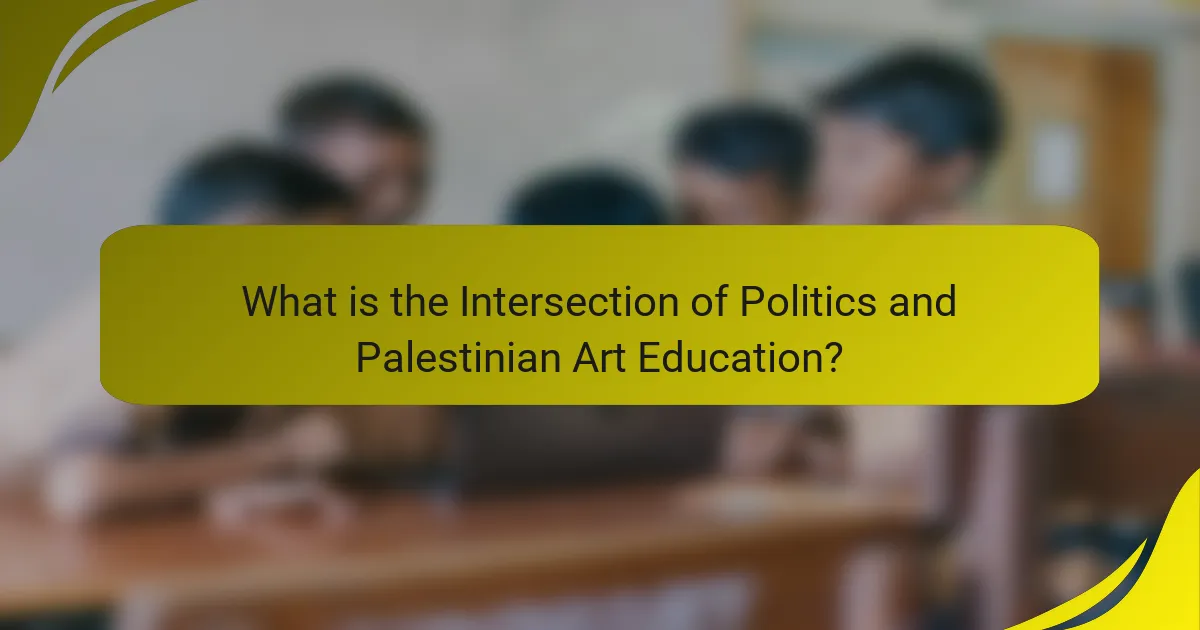
What is the Intersection of Politics and Palestinian Art Education?
The intersection of politics and Palestinian art education is characterized by the influence of sociopolitical contexts on artistic expression and educational frameworks. Palestinian art education often serves as a means of political activism. It reflects the struggles and aspirations of the Palestinian people. The curriculum integrates themes of identity, resistance, and cultural heritage. This approach fosters awareness of the political landscape among students. Art becomes a tool for advocacy and social change. Historical events, such as the Nakba, are often incorporated into art education. This integration helps students understand their cultural narratives within a political context.
How does politics influence Palestinian art education?
Politics significantly influences Palestinian art education by shaping the curriculum and access to resources. Political conditions often restrict freedom of expression in educational settings. This limitation affects the themes and subjects that can be explored in art classes. For example, the ongoing conflict impacts the representation of Palestinian identity in art. Additionally, political narratives can dictate funding for art programs. Schools may prioritize certain artistic expressions over others based on political agendas. The educational policies also reflect broader societal issues, affecting how art is taught and perceived. Overall, the intersection of politics and art education in Palestine is deeply intertwined with the struggle for cultural identity and representation.
What are the historical contexts affecting Palestinian art education?
Palestinian art education is significantly influenced by historical contexts such as occupation, displacement, and cultural resistance. The Israeli-Palestinian conflict has imposed restrictions on educational resources and freedom of expression. This has led to a focus on art as a means of political expression and identity formation. The 1948 Nakba, which resulted in the displacement of Palestinians, has shaped the narrative within art education. Additionally, the Oslo Accords in the 1990s introduced new challenges and opportunities for curriculum development. Local and international organizations have sought to promote art education as a form of resistance. The emphasis on cultural heritage and storytelling is evident in many art programs. These contexts collectively inform the methodologies and objectives of Palestinian art education today.
How do political movements shape art curricula in Palestine?
Political movements significantly shape art curricula in Palestine by integrating themes of resistance and cultural identity. These movements influence educational content to reflect the socio-political realities faced by Palestinians. Art education often includes projects that address issues like occupation and displacement. This approach fosters critical thinking and social awareness among students. For example, various art programs encourage students to express their experiences through visual arts. Additionally, political movements advocate for the inclusion of traditional Palestinian art forms in curricula. This incorporation helps preserve cultural heritage and promotes national identity. Research indicates that art serves as a medium for activism in Palestinian society. Thus, the intersection of politics and art education is vital for fostering a sense of community and resilience.
What role does activism play in Palestinian art education?
Activism plays a crucial role in Palestinian art education by fostering critical awareness and social change. It integrates political themes into the curriculum, encouraging students to express their identities and experiences. Activist art often addresses issues like occupation, displacement, and cultural heritage. This engagement helps students develop a sense of agency and responsibility towards their community. Research shows that art education infused with activism can enhance students’ emotional and social development. For instance, programs that incorporate activism have been linked to increased engagement and motivation among students. Thus, activism not only enriches the educational experience but also empowers the next generation of Palestinian artists.
How do artists use education as a form of activism?
Artists use education as a form of activism by integrating social issues into their teachings. They create curricula that highlight political struggles and cultural identities. This approach raises awareness among students about systemic injustices. For instance, art workshops often focus on themes of resistance and resilience. Artists also collaborate with educational institutions to promote critical thinking. They engage students in discussions about their rights and representation. Additionally, exhibitions can serve as educational platforms for marginalized voices. This method empowers individuals to express their experiences and advocate for change.
What are some notable examples of activist art education in Palestine?
Notable examples of activist art education in Palestine include the “Freedom Theatre” in Jenin. This organization uses theater as a form of resistance and empowerment. It provides training in acting, directing, and production to youth. The “Sakakini Cultural Center” in Ramallah also promotes art education. It hosts workshops and exhibitions that address social and political issues. Additionally, “Art and Freedom” is an initiative that combines art with activism. It encourages artists to express their views on occupation and identity. These institutions play a crucial role in fostering critical thinking and creativity among Palestinians. They serve as platforms for dialogue and cultural expression.
How does awareness of political issues manifest in Palestinian art education?
Awareness of political issues manifests in Palestinian art education through the incorporation of themes related to identity, resistance, and cultural heritage. Art educators in Palestine often encourage students to explore their socio-political context. This includes creating works that reflect the struggles and aspirations of the Palestinian people. The curriculum frequently integrates historical narratives and contemporary issues. Students engage with art as a form of activism. They use various mediums to express their perspectives on occupation and displacement. Projects may involve community collaboration and public exhibitions. Such initiatives aim to raise awareness and foster dialogue about political realities. This approach not only nurtures artistic skills but also cultivates critical thinking and social responsibility among students.
What themes are prevalent in Palestinian art related to political awareness?
Prevalent themes in Palestinian art related to political awareness include resistance, identity, and displacement. Resistance is often depicted through imagery that challenges oppression and advocates for freedom. Artists express their cultural identity by incorporating traditional motifs and symbols. Displacement is a recurring theme, representing the struggles of Palestinian refugees. Many artworks reflect the impact of occupation on daily life. The use of visual storytelling conveys the emotional weight of these experiences. Historical events, such as the Nakba, are frequently referenced in artistic expressions. These themes collectively highlight the socio-political context of Palestinian life. They serve to raise awareness and foster solidarity within and beyond the Palestinian community.
How do educators incorporate current events into art lessons?
Educators incorporate current events into art lessons by integrating relevant themes and issues into their curriculum. They encourage students to explore social, political, and environmental topics through various artistic mediums. For instance, art projects may focus on recent protests, humanitarian crises, or cultural movements. This approach fosters critical thinking and allows students to express their perspectives creatively. Educators often use visual art to respond to current events, helping students connect with their surroundings. Research shows that engaging with contemporary issues enhances students’ understanding of the world. By creating art that reflects current events, students develop a sense of agency and awareness.
What are the key components of integrating politics into art curricula?
The key components of integrating politics into art curricula include critical engagement, contextual understanding, and interdisciplinary approaches. Critical engagement encourages students to analyze political themes within art. Contextual understanding helps students grasp the socio-political environment influencing artistic expression. Interdisciplinary approaches incorporate history, sociology, and political science into art education. This integration fosters awareness of political issues and empowers students to express their perspectives. Research shows that art can be a powerful medium for political activism, enhancing student engagement and social consciousness.
How can educators balance artistic expression and political content?
Educators can balance artistic expression and political content by fostering an inclusive environment. This involves encouraging open dialogue about political themes in art. Educators should provide context for political issues while respecting diverse viewpoints. They can integrate art history that includes political movements. Assignments can focus on personal expression while allowing political commentary. Clear guidelines can help students navigate sensitive topics. Educators should also promote critical thinking about the impact of art on society. Research shows that art education can enhance civic engagement and awareness.
What strategies can be used to effectively teach politically charged art?
Engaging students through discussion is a key strategy for teaching politically charged art. Discussions allow students to express their views and understand diverse perspectives. Incorporating historical context enhances the learning experience. This context provides background on the political issues depicted in the art. Utilizing contemporary examples makes the subject matter relevant. Current events can illustrate the ongoing impact of political art. Encouraging critical thinking is essential. Students should analyze the intent and impact of the artwork. Collaborative projects foster a deeper understanding of the themes. Group work allows for shared insights and diverse interpretations. Finally, creating a safe space for dialogue is crucial. This environment promotes open communication and respect for differing opinions.
What challenges do educators face in integrating politics into art education?
Educators face several challenges in integrating politics into art education. One major challenge is the potential backlash from parents and administrators. This can lead to concerns about appropriateness and content sensitivity. Another challenge is the varying levels of political awareness among students. This disparity can create difficulties in facilitating discussions. Additionally, educators may lack training in addressing political topics effectively. This can hinder their ability to guide students through complex issues. The cultural context also plays a significant role. In politically charged environments, educators must navigate potential risks to their safety and job security. These factors contribute to a complex landscape for integrating politics into art education.
How do political restrictions impact art education in Palestine?
Political restrictions significantly hinder art education in Palestine. These restrictions limit access to resources and materials necessary for artistic expression. Schools often face challenges in obtaining basic art supplies due to financial constraints imposed by political situations. Additionally, the curriculum is influenced by political ideologies, which may suppress creative freedom. Restrictions on movement further affect students’ ability to attend workshops or exhibitions. For instance, the blockade on Gaza has resulted in limited exposure to diverse artistic practices. Such limitations stifle creativity and reduce opportunities for cultural exchange. This environment creates a challenging landscape for aspiring artists in Palestine.
What are the ramifications of censorship on Palestinian art education?
Censorship significantly impacts Palestinian art education by limiting creative expression. It restricts students’ ability to explore and represent their cultural identity. This suppression can lead to a lack of critical thinking and innovation in artistic practices. Furthermore, censorship can diminish the quality of art education by removing essential historical and political contexts. Students may receive a skewed understanding of their heritage and current realities. Reports indicate that censorship can also discourage educators from teaching controversial topics. This environment stifles artistic voices and hinders the development of a vibrant art community. Ultimately, censorship undermines the potential for art to serve as a tool for activism and social change.
What best practices can enhance the integration of politics in art education?
Incorporating politics into art education can be enhanced through several best practices. First, educators should integrate political themes into art projects. This allows students to explore contemporary issues through creative expression. Second, incorporating diverse perspectives is essential. Engaging with artists from various political backgrounds enriches the curriculum. Third, fostering discussions about political art can deepen understanding. Facilitated dialogues encourage critical thinking about social issues. Fourth, utilizing local political contexts is beneficial. This makes learning relevant and immediate for students. Fifth, encouraging community engagement through art projects promotes activism. Collaborating with local organizations can amplify students’ voices. Lastly, providing resources on political art history is crucial. This context helps students appreciate the role of art in activism.
How can collaboration with local communities improve art education?
Collaboration with local communities can significantly enhance art education by fostering culturally relevant practices. Engaging local artists and community members brings real-world perspectives into the classroom. This connection helps students understand their cultural heritage and encourages self-expression.
Research shows that community-based art programs improve student engagement and creativity. A study by the Arts Education Partnership found that students involved in community collaborations demonstrate higher achievement in art and other subjects.
Additionally, partnerships with local organizations provide resources and mentorship opportunities. These connections can lead to workshops, exhibitions, and community art projects. Such initiatives not only enrich the learning experience but also strengthen community ties and promote social awareness.
What resources are available for educators to teach politically engaged art?
Educators can access various resources to teach politically engaged art. Notable resources include online platforms like Art21, which offers documentaries and lesson plans focused on contemporary art and social issues. The National Art Education Association provides professional development and curriculum resources that emphasize social justice themes. Additionally, books such as “Art and Activism: Projecting Social Change” by J. K. McCarthy provide insights into integrating activism into art education. Websites like Teaching Tolerance offer lesson plans that address political themes in art. These resources support educators in fostering discussions about political engagement through art.
The main entity of the article is the intersection of politics and Palestinian art education. The article examines how political contexts influence artistic expression and educational frameworks in Palestine, highlighting the role of art as a tool for activism and social change. It discusses the integration of themes such as identity, resistance, and cultural heritage within the curriculum, shaped by historical events and current political movements. Additionally, the article addresses the challenges educators face in incorporating political content into art education and explores best practices for enhancing this integration through community collaboration and resource utilization.
